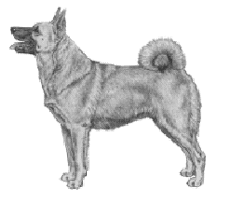Norwegian Buhund
General Information - Norwegian Buhund

Group:
Working
Size:
medium
Lifespan:
13-15 years
Exercise:
high
Grooming:
low
Trainability:
low
Watchdog ability:
very high
Protection ability:
medium
Area of Origin:
Norway
Date of Origin:
ancient times
Other Names:
Norsk Buhund
Original Function:
Guardian and herder
History
The Norwegian Buhund, also known as the Norsk Buhund, originated in Norway, and dates back to the 800's. It is a medium sized Spitz-like dog that was used to guard and herd on the farm. It is thought that this dog is the ancestor of many Icelandic breeds as it was brought there in the late 800's. Besides Norway, this dog can be found in good numbers in England and Australia.
Temperament
The Norwegian Buhund is a brave dog, companionable with people, and does well with children, and so if often thought of as an ideal family pet. It is also an intelligent, energetic, and sometimes stubborn dog that doesn't enjoy being left alone and idle all day He will bark. Early training is recommended.
Upkeep
The Norwegian Buhund needs daily exercise and enjoys a long walk or good run in a safe area. It can live outdoors in temperate to cool climates. It does best when allowed access to both house and yard. Its coat needs brushing one or two times weekly, more often during heavy shedding periods.
Norwegian Buhund
A breed standard is the guideline which describes the ideal characteristics, temperament, and appearance of a breed and ensures that the breed is fit for function with soundness essential. Breeders and judges should at all times be careful to avoid obvious conditions and exaggerations, as well as being mindful of features which could be detrimental in any way to the health, welfare or soundness of this breed.
Breed Standard - Norwegian Buhund
 Characteristics
Characteristics: The Norwegian Buhund should be fearless and brave.
General Appearance: The Norwegian Buhund is a typical Spitz dog of under middle size, lightly built, with a short compact body, fairly smooth:lying coat, erect pointed ears, tail carried curled over the back, and with an energetic character. It is of prime importance that the Buhund should be a well-balanced dog, free from all exaggeration and should be capable of the arduous work for which it is bred.
Head and Skull: Lean, light, rather broad between the ears, wedge shaped, narrowing towards the point of the nose. Skull and back of head almost flat; marked but not sharp stop; muzzle of medium length, tapering evenly from above and side, with straight bridge; lips tightly closed.
Eyes: Not protruding, colour dark brown, lively with a fearless expression.
Ears: Placed high, erect, the height greater than the base; sharply pointed and very mobile.
Neck: Medium length, lean without loose skin, good carriage.
Forequarters: Legs lean, straight and strong, elbows tightly placed.
Body: Strong and short, but light; chest deep with good ribs; straight line of back, good loins, strong couplings, slightly drawn up.
Hindquarters: Only a little angulated, straight when seen from behind.
Feet: Rather small, oval in shape, with tightly closed toes.
Tail: Placed high on, short, thick and hairy, but without long hair, tightly curled.
Coat: Close and harsh, but smooth; on head and front legs: short, close and smooth; longer on chest, neck and shoulders and back of legs and inside of tail curl. The coat is made up of harsh top hair, with soft wool undercoat.
Colour: Wheaten (biscuit), black, red (if the red is not too dark), wolf:sable. Preferably self:coloured but small symmetric markings such as white on chest and legs, blaze on head and narrow ring on neck, black masks and ears and black tips to the tail are permissible.
Size: Dogs not more than 45 cm (17.5 in); bitches somewhat less.
Faults: White dogs. Light eyes. Light nose. Undershot or overshot mouth. Drop ear.
Note: Male animals should have two apparently normal testicles fully descended into the scrotum.
DNZ No 532
Copyright Dogs New Zealand
01 Jan 2002
Any departure from the foregoing points should be considered a fault and the seriousness with which the fault should be regarded should be in exact proportion to its degree and its effect upon the health and welfare of the dog and on the dog’s ability to perform its traditional work.




